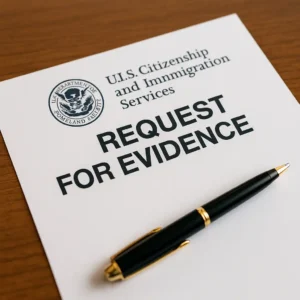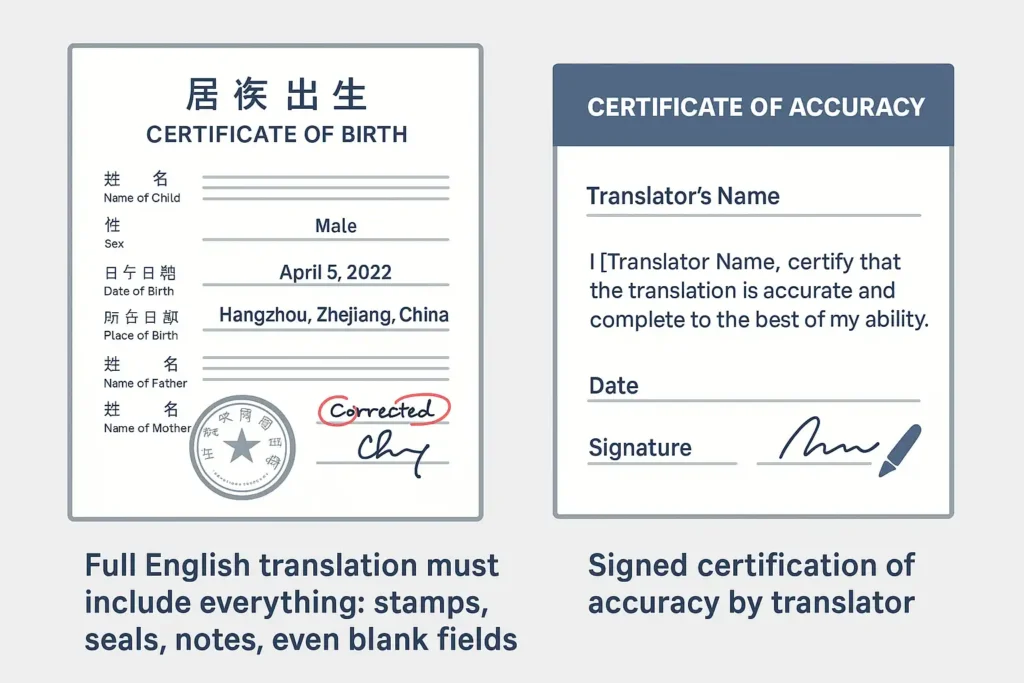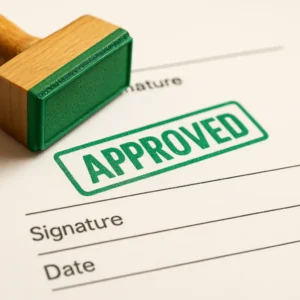The Problem
Immigration translation is the key to avoiding USCIS delays. Your client submits every document for a green card—birth certificates, marriage records, police clearances. Everything looks perfect. Weeks later, USCIS sends a dreaded Request for Evidence (RFE).
The Law
8 CFR §103.2(b)(3) is crystal clear:
“Any document containing foreign language submitted to USCIS shall be accompanied by a full English translation which the translator has certified as complete and accurate, and by the translator’s certification that he or she is competent to translate from the foreign language into English.”
If the document goes to USCIS or EOIR, it must be certified. Anything less puts your case at risk.

That single oversight could cost your client months of delay, a missed filing deadline, or even outright denial.
The truth is, the line between certified and non-certified translations isn’t just paperwork—it’s the difference between approval and rejection.In this guide, we’ll unpack what every U.S. immigration lawyer must know about translation compliance, using real regulations, case examples, and practical workflows you can apply immediately.
Why This Distinction Matters
Certified vs. non-certified isn’t paperwork. It’s the difference between:
- Approval vs. rejection
- Smooth processing vs. months of delay
- Client trust vs. malpractice claims
What Exactly Is a Certified Translation?
A certified immigration translation includes:
- A full English translation of the document (stamps, seals, notes, even blank fields).
- A signed certificate of accuracy by the translator.
Tip: USCIS does not require notarization. Certification is enough.

Example Certification Statement:
Certification of Translation Accuracy
I, [Translator Full Name], certify that I am competent to translate from [Language] into English, and that the attached translation is a complete and accurate translation of the attached [Document Type]. Translator: [Full Name] Signature: _____________ Date: [Month Day, Year]
This certification is what USCIS looks for when deciding whether a document is legally valid.
Common Mistakes Lawyers See—and How to Fix Them
Mistake 1: Skipping details
- Leaving out seals, stamps, or handwritten notes.
- Fix: Translate everything. Use “[Blank]” or “[Illegible]” when necessary.
Mistake 2: Wrong format
- Submitting paragraph-style translations when line-by-line is required.
- Fix: Match the format expected by USCIS, EOIR, or consulates.
Mistake 3: Name mismatches
- Passport says “Wei Lee,” translation says “Li Wei.”
- Fix: Always mirror ID spelling. Add notes if multiple spellings exist.
Mistake 4: No certification statement
- Translation looks fine but gets rejected.
- Fix: Always attach a signed certificate of accuracy.
Mistake 5: Relying on machine translation
Fix: Only use professional human translators for filings.
Google Translate renders “登记日期” as “birthday.”
Certified vs. Notarized vs. Apostille
| Type | What It Is | Required by USCIS? | Use Case |
|---|---|---|---|
| Certified | Translator certifies accuracy | ✅ Yes | USCIS & EOIR filings |
| Notarized | Translator’s signature notarized | ❌ No | Some state/county filings |
| Apostille | Hague authentication of document | ❌ No | Foreign consulates/jurisdictions |
Templates You Can Use
Certification Statement
“I, [Translator Full Name], certify that I am competent to translate from [Language] into English, and that the attached translation is a complete and accurate translation of the attached [Document Type].
Translator: [Name]
Signature: _________ Date: ________”
Law Firm Intake Checklist
☑ Non-English docs received?
☑ Stamps/seals visible?
☑ Names and dates match?
☑ Certified translation needed?
The Risk If You Ignore This
- RFEs under 8 CFR §103.2(b)(8)
- Denials for missing certification
- Delays that frustrate clients
- Malpractice exposure
The Solution for Law Firms
- Build a panel of trusted certified translators.
- Standardize an intake checklist for every non-English document.
- Ensure every translation comes with a signed certificate of accuracy.
Final Word: Protect Your Clients, Protect Yourself

Certified translations are not a luxury—they’re compliance. One missing certification can undo months of casework.
If your firm handles immigration filings, you need airtight translation workflows.
- Birth, marriage, divorce, adoption documents
- Police clearances and court records
- Diplomas and transcripts
Fast delivery.No rush fees. Every translation certified
| Ready to File Without Stress? Don’t risk delays, RFEs, or rejections. Get your immigration translation certified the first time. 👉 Contact us today for a free quote |
